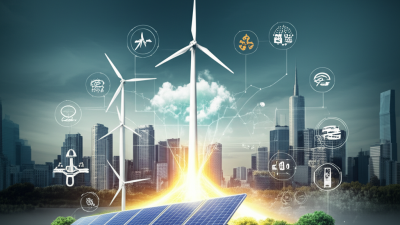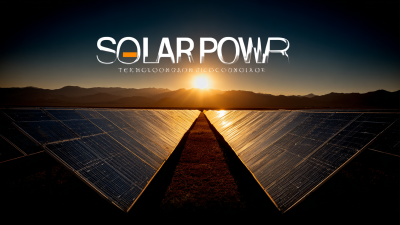Unlocking the Future: How Solar and Power Innovations Are Transforming Our World
In an era marked by rapid technological advancements and an urgent need for sustainable solutions, the realm of Solar and Power innovations stands at the forefront of transformation. The pressing challenges of climate change and energy scarcity have propelled society toward exploring renewable sources, with solar energy taking center stage. From efficient photovoltaic cells to groundbreaking battery storage systems, these innovations not only promise to reshape the energy landscape but also have the potential to enhance economic growth and create green jobs. As we delve into the nuances of how Solar and Power technologies are unlocking a more sustainable and resilient future, it becomes evident that the synergy between innovation and environmental consciousness is crucial. This journey towards harnessing solar energy and optimizing power usage is not just a trend but a necessary evolution in our quest for a cleaner and more equitable world.

The Rise of Solar Energy: A New Era of Sustainability
The rise of solar energy signifies a pivotal shift towards sustainability in our energy landscape. According to the International Energy Agency (IEA), solar power capacity surged to over 940 gigawatts globally in 2022, an impressive increase of approximately 20% compared to the previous year. This momentum is a clear indication that solar energy is no longer just an alternative but has become a cornerstone of the world’s renewable energy mix.
Moreover, the latest data from BloombergNEF highlights that the cost of solar photovoltaic (PV) systems has dropped by over 85% since 2010, making it one of the most affordable energy sources available. This affordability, coupled with advancements in battery storage technologies, allows for greater energy access and reliability, enabling homes and businesses to transition towards self-sustaining energy models. With a projected 40% of the world’s electricity likely to come from renewable sources by 2030, the impact of solar energy on global sustainability efforts is profound and transformative.
Innovative Technologies Shaping the Future of Power Generation
Innovative technologies are at the forefront of transforming power generation, with advancements in
solar energy and artificial intelligence (AI) leading the charge.
As outlined in the "2024 AI Status Report," AI is set to revolutionize the energy sector by enhancing efficiency and optimizing resource management.
For instance, the integration of AI in energy storage systems is predicted to reshape power grids by allowing for better balance between generation and consumption.
With the continued advancement of AI, the industry could see a
doubling of economic value derived from generative AI technologies within the next three years, further emphasizing the
importance of innovation in energy production.
Moreover, the concept of a collaborative energy system, which encompasses sources, networks, loads, and storage (源网荷储), is emerging as a necessary pathway for energy transition.
Insights from industry leaders suggest that AI-driven solutions in energy management will facilitate a more resilient and flexible power infrastructure, catering to the evolving demands of consumers and institutions alike.
As we navigate this transformative era, the adoption of solar and AI technologies will undoubtedly play a pivotal role in shaping the future landscape of power generation.
The Impact of Solar Power on Global Energy Markets
As the world grapples with climate change and seeks sustainable energy solutions, solar power has emerged as a game-changer in global energy markets. According to the International Energy Agency (IEA), solar energy capacity has been growing at an unprecedented rate, with more than 890 GW installed globally by the end of 2021. This rapid expansion has not only made solar the fastest-growing source of electricity but has also reshaped energy consumption patterns, driving down costs significantly. The levelized cost of solar power has plummeted over 80% since 2010, making it one of the most affordable energy sources available today.
Furthermore, the transition to solar power is influencing energy policies worldwide. A recent report from Bloomberg New Energy Finance predicts that solar installations could account for 50% of global electricity generation by 2050, directly impacting fossil fuel demand and production. This shift not only fosters energy independence for many countries but also stimulates job creation, with solar industry employment projected to reach 24 million jobs globally in the same time frame. As investments in solar technologies continue to increase, the energy landscape is undergoing a radical transformation that promises a cleaner and more sustainable future.
Unlocking the Future: How Solar and Power Innovations Are Transforming Our World - The Impact of Solar Power on Global Energy Markets
| Country/Region | Solar Energy Capacity (GW) | Percentage of Total Energy Consumption (%) | Growth Rate (Annual %) for Solar Installation | Investment in Solar Energy (Billion USD) |
|---|---|---|---|---|
| United States | 92.5 | 12.5 | 20 | 18.5 |
| China | 305.0 | 24.0 | 25 | 54.0 |
| Germany | 59.0 | 10.0 | 10 | 15.2 |
| India | 55.0 | 8.0 | 30 | 10.9 |
| Australia | 25.0 | 17.3 | 15 | 7.5 |
Integrating Solar Innovations into Urban Infrastructure
The integration of solar innovations into urban infrastructure is poised to revolutionize the way cities harness energy. With the increasing demand for sustainable development, urban planners are increasingly incorporating solar technologies into building designs, transportation systems, and public spaces. Solar panels installed on rooftops, as well as innovative solar roads, not only provide clean energy but also reduce the city's carbon footprint. This transformation ensures that urban environments can become self-sufficient in energy supply while promoting greener lifestyles.
Moreover, the implementation of solar innovations enhances resilience against energy shortages and price fluctuations. Cities that adopt integrated solar systems can better manage their energy consumption and rely less on traditional fossil fuels. This shift leads to reduced energy costs for municipalities and citizens alike. As cities continue to evolve, embracing solar-powered solutions will play a crucial role in creating smart, sustainable urban ecosystems, positioning them as leaders in the fight against climate change while improving the quality of life for their residents.
Challenges and Opportunities in the Solar Energy Transition
The solar energy transition presents both challenges and opportunities in the quest for a more sustainable future. According to the International Energy Agency (IEA), solar power capacity worldwide is expected to exceed 1,000 gigawatts by 2025, making it one of the fastest-growing energy sources. However, the rapid adoption of solar technology faces several hurdles, including the high initial investment costs, the need for infrastructural upgrades, and regulatory frameworks that often lag behind technological advancements.
Moreover, integrating solar energy into existing power grids poses significant technical challenges. The intermittency of solar generation requires enhanced storage solutions and smart grid technologies to maintain a steady supply of electricity. The U.S. Department of Energy has reported that improving energy storage capabilities could increase the efficiency of solar power systems by up to 20%. While these challenges may seem daunting, they also present unique opportunities for innovation and economic growth. New technologies and business models are emerging to address these barriers, potentially leading to a more resilient and diverse energy landscape.
Related Posts
-

Mastering Smart Power Solar: Your Ultimate Guide to Sustainable Energy Solutions
-

Harnessing Best Solar Power Technology in the 2025 Industry Trends for Global Sourcing Solutions
-

Navigating Import and Export Certifications for New Solar Power Technology Success
-

Exploring the Unique Advantages of Solar Power Solutions and Their Best Applications
-

How to Harness Power Smart Solar for Maximum Energy Efficiency
-

Unlock the Potential of Solar With Light Innovations for Sustainable Global Sourcing